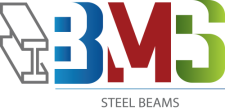Our Range

Universal Beams
Sometimes known as Girders, Lintels, H-sections, I-sections or U-beams
Whatever size you require, our universal steel beams are fabricated to our outstanding standards.
Universal beams are used in many construction projects including residential properties and large commercial or industrial sites as well as civil engineering projects such as bridges and tunnels.
Our steel beams come in a wide range of sizes and are manufactured to a high quality at our site in Emsworth.
It is important that the beam required is measured correctly before ordering so if you have any questions, call 01243 379568
RSJs
An I-beam, also known as H-beam (for universal column, UC), w-beam (for “wide flange”), universal beam (UB), rolled steel joist (RSJ), or double-T is a beam with an I or H-shaped cross-section. The horizontal elements of the “I” are known as flanges, while the vertical element is termed the “web”. Our I-beams are made of structural steel and are used in construction and civil engineering.
The w-beam resists shear forces, while the flanges resist most of the bending moment experienced by the beam. Beam theory shows that the I-shaped section is a very efficient form for carrying both bending and shear loads in the plane of the web. On the other hand, the cross-section has a reduced capacity in the transverse direction, and is also inefficient in carrying torsion, for which hollow structural sections are often preferred.
PFC (Parallel Flange Channels)
The structural channel, also known as a C-channel or Parallel Flange Channel (PFC), is a type of (usually structural steel) beam, used primarily in building construction and civil engineering. Its cross section consists of a wide “web”, usually but not always oriented vertically, and two “flanges” at the top and bottom of the web, only sticking out on one side of the web. It is distinguished from I-beam or H-beam or W-beam type steel cross sections in that those have flanges on both sides of the web.
The structural channel is not used as much in construction as symmetrical beams, in part because its bending axis is not centred on the width of the flanges. If a load is applied equally across its top, the beam will tend to twist away from the web. This may not be a weak point or problem for a particular design, but is a factor to be considered.
Channels or C-beams are often used where the flat, back side of the web can be mounted to another flat surface for maximum contact area. They are also sometimes welded together back-to-back to form a non-standard I-beam.
Sections
- Mild Steel Flat Bars – Hot Rolled Steel Flat, is widely used for all general fabrication and repairs in industrial maintenance, agricultural implements, transportation equipment, etc
- Steel Rounds – Round Bar is a long, cylindrical metal bar stock that has many industrial and commercial applications. The most common application is shafts
- Steel Hollow Sections – A hollow structural section (HSS) is a type of metal profile with a hollow tubular cross section.
- Square Hollow Sections – also known as Cold Formed Square Hollow, Square Mild Steel Hollow
- Rectangular Hollow Section – also known as Cold Formed Rectangular Hollow, Rectangular Mild Steel Hollow
- Circular Hollow Section – also known as Cold Formed Hollow Section, Circular Mild Steel Hollow, Hollow Round
- Steel Columns – also known as Universal Columns (UC), Lintels, Girders, Rolled Steel Joists (RSJ's), I Beams, H Beams, I Sections, H Sections
- Steel Plates – also known as hot rolled coil, hot rolled plate or simply metal plate. Available from 3mm-80mm thickness. This multi-purpose steel plate is highly versatile, as well as incredibly strong and durable.
- Hollow Section – Steel hollow sections are the most versatile and efficient form for construction and mechanical applications. Many of the strongest and most impressive structures in the world today use hollow sections.
- RSJ Steel Beams – Available in all sizes
Angles
- Equal angles – Steel Angles are the most basic type of roll-formed steel. ... Angle Steel is “L” shaped; the most common type of Steel Angles are at a 90 degree angle. The legs of the “L” can be equal or unequal in length. Steel angles are used for various purposes in a number of industries.
- Unequal angles – We supply a wide range of unequal angles ranging in size from 20x20 up to 200x200, in a variety of thicknesses. Stock lengths are 6000mm but 12000mm lengths are available in some sizes.
If you would like any advice or wish to discuss an order, please contact BMS Steels, Emsworth, Hampshire on 01243 379568 or email sales@bms-metalworks.co.uk

